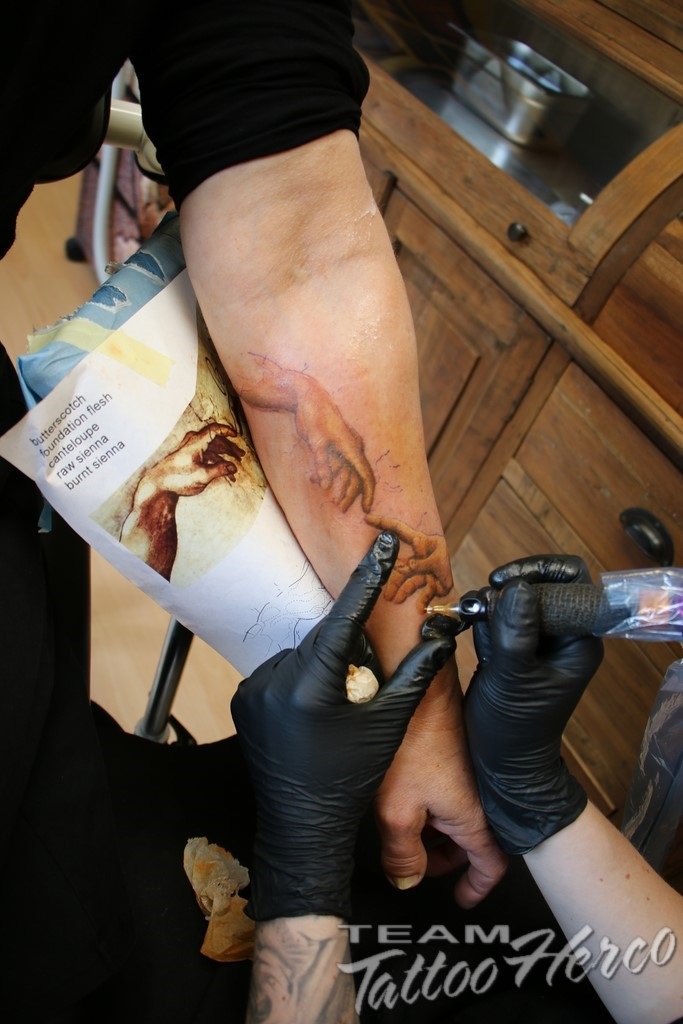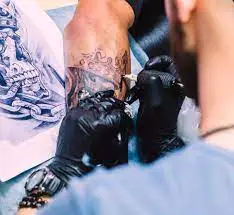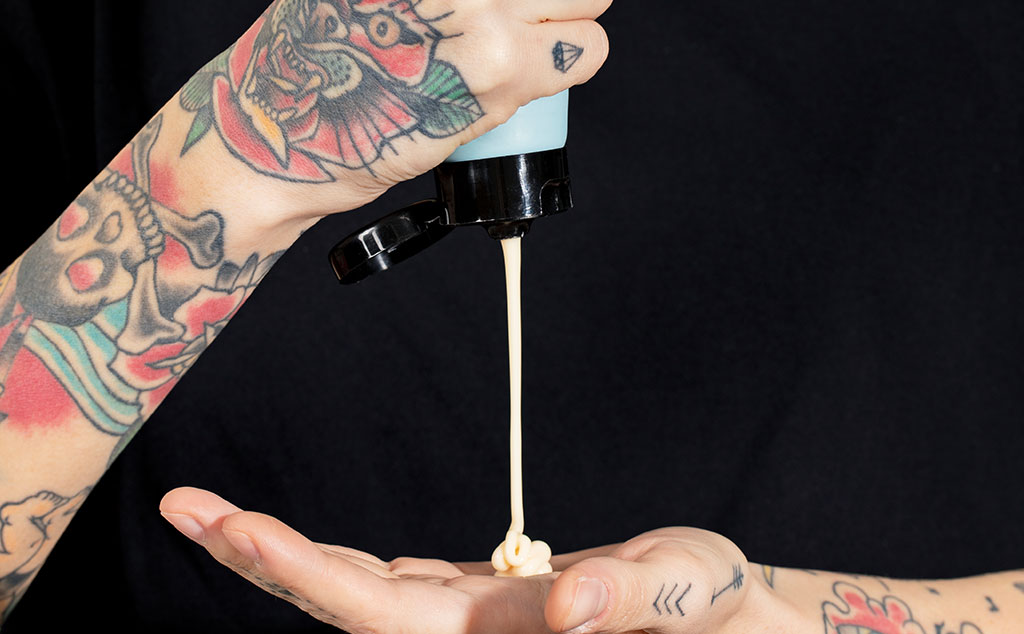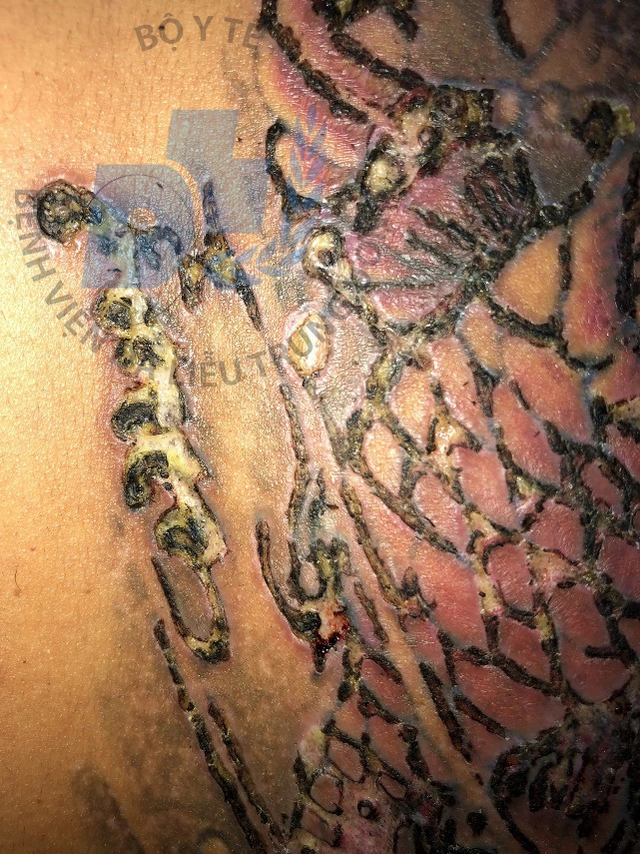You just got inked and now you're wondering, "what to do after getting a tattoo?" The truth is, getting a tattoo is only half the battle, what happens next determines whether your new artwork becomes a masterpiece or a regret. At H2M Tattoo Studio, we've seen countless clients transform their healing experience simply by following the right aftercare steps. Your fresh tattoo will go through distinct healing phases over the next 2-4 weeks, starting as an open wound that requires careful attention, then progressing through peeling, itching, and gradual regeneration. We combines dermatological best practices with proven techniques from experienced tattoo artists to ensure your investment heals beautifully and maintains its stunning vibrancy for years to come.
Why Should You Care What to Do After Getting a Tattoo?
Your tattoo represents a significant financial and emotional investment—typically costing hundreds of dollars and embodying personal meaning that will last a lifetime. However, even the most skillfully executed tattoo can be permanently ruined by poor aftercare decisions in the critical weeks following your session. Statistics from dermatological studies show that nearly 30% of tattoo complications, including infections, color loss, and scarring, stem directly from inadequate post-procedure care rather than issues with the tattooing process itself.
The healing process transforms your fresh tattoo through three distinct biological phases: the inflammatory response (days 1-3) when your body treats the tattoo as a wound, the proliferative phase (days 4-14) during which new skin cells form and the tattoo may appear cloudy, and finally the maturation stage (weeks 3-4 and beyond) when colors settle into their permanent appearance. Each phase presents unique vulnerabilities that require specific care approaches, and mistakes during any stage can compromise your final results.

Getting a new tattoo is an exciting milestone, but the journey doesn't end when you leave the tattoo parlor. Proper tattoo aftercare isn't just recommended—it's essential for preventing infections, preserving vibrant colors, and ensuring your artwork looks as stunning years from now as it does today.
>>>> READ MORE: what to moisturize tattoo with To Recover Quickly And Keep The Color Lasting And Beautiful
What To Do After Getting A Tattoo In The First 24 Hours
The first day after getting tattooed is critical for establishing proper healing conditions. Your tattoo artist has just created thousands of tiny wounds in your skin and how you care for these wounds in the initial hours sets the foundation for the entire healing process.
After completion, your tattoo artist will cover your fresh tattoo with a protective bandage immediately. This initial covering serves multiple purposes: it protects against bacteria, prevents clothing from sticking to the wound and allows your body to begin the healing process in a controlled environment.
- Traditional bandages: Remove after 2-4 hours, never leave traditional bandages on overnight because it easily retains moisture and accumulates bacteria.
- Saniderm or Tegaderm: Can remain for 3-5 days as directed by your artist
First Cleaning Steps
After removing the bandage, your first cleaning is crucial for removing surface bacteria and preparing your tattoo for the healing process. Use lukewarm water and a fragrance-free, antibacterial soap such as Dial Gold or Cetaphil Gentle Skin Cleanser.
- Wash your hands thoroughly for at least 20 seconds
- Gently rinse the tattoo with lukewarm water
- Apply a small amount of mild soap using clean fingertips
- Gently wash in circular motions - avoid scrubbing
- Rinse thoroughly until all soap residue is removed
- Pat dry with a clean paper towel or let air dry
Avoid using washcloths, loofahs, or any abrasive materials that could irritate the fresh tattoo or introduce bacteria. Wash your tattoo 2-3 times daily during the first week, then reduce to 1-2 times daily as healing progresses.
Initial Moisturizing
Once your tattoo is completely dry, apply a thin layer of recommended aftercare ointment. During the first few days such as Aquaphor Healing Ointment, A&D Original Ointment, or specialized tattoo aftercare products like Hustle Butter or After Inked.
Apply only a thin layer because over-moisturizing can suffocate the tattoo and delay healing. After gently pat the ointment onto the tattoo using clean hands, avoiding any rubbing motions that might irritate the fresh ink. Reapply 2-3 times daily or whenever tattoo feels tight or dry.
After the first few days, transition from heavy ointments to lighter, fragrance-free lotions. The best moisturizers for healing tattoos are unscented and contain minimal ingredients to reduce the risk of allergic reactions. Popular dermatologist-recommended options include CeraVe Daily Moisturizing Lotion, Eucerin Original Healing Cream, and Aveeno Daily Moisturizing Lotion.

>>>> SEE MORE: can you put sunscreen on a healing tattoo ? Common Mistakes To Avoid
What to Avoid What to Do After Getting a Tattoo
Understanding what can damage your healing tattoo is just as important as knowing what helps it heal. Certain activities and exposures can lead to infection, fading, scarring, or poor healing outcomes.
Water Exposure Risks
Prolonged water exposure poses serious risks to healing tattoos, including bacterial infection, ink loss, and delayed healing. Your fresh tattoo essentially consists of thousands of tiny open wounds that become vulnerable when exposed to bacteria-rich water sources.
Avoid for minimum 2-4 weeks:
- Swimming pools (chlorine damages healing skin)
- Hot tubs and jacuzzis (bacteria breeding grounds)
- Ocean swimming (salt water and bacteria)
- Long baths or soaking (softens scabs, increases infection risk)
Brief showers are fine, but avoid directing water pressure directly onto your tattoo. Keep shower time under 10 minutes and avoid very hot water, which can cause swelling and irritation.
Sunlight and UV Protection
UV radiation can cause significant damage to healing tattoos, leading to fading, uneven healing, and increased scarring risk. Fresh tattoos are particularly vulnerable because the skin's protective barrier is compromised.
During the first 2-3 weeks, keep your tattoo completely covered when outdoors or avoid direct sunlight entirely. Once fully healed, always apply broad-spectrum SPF 30 or higher sunscreen to preserve your tattoo's vibrancy. UV damage is cumulative, so consistent sun protection throughout your tattoo's lifetime will maintain its appearance significantly better than sporadic protection.
Avoiding Mechanical Irritation
Friction, pressure, and irritation can disrupt the healing process and affect your tattoo's final quality. Your healing skin is delicate and easily damaged by seemingly minor irritants.
Common sources of mechanical irritation:
- Tight clothing rubbing against the tattoo
- Sleeping on the fresh tattoo
- Scratching or picking at healing skin
- Excessive touching or handling
- Rough towels or bedding
Choose loose-fitting, breathable clothing made from soft materials like cotton. If your tattoo is in an area that contacts bedding, consider using clean, soft sheets and sleeping in positions that minimize pressure on the healing area.

>>>> READ MORE: can i drink beer after a tattoo ? Important Things You Need To Know
Identifying and Managing Complications
While most tattoos heal without serious complications, recognizing warning signs early can prevent minor issues from becoming major problems. Understanding when to seek professional help protects both your health and your investment in your tattoo.
Recognizing Infection and Allergic Reactions
Mild redness, swelling, and tenderness are normal during the first few days, but certain symptoms warrant immediate attention. Infections can develop rapidly and require prompt medical treatment.
Warning signs of infection:
- Increasing redness that spreads beyond the tattoo area
- Red streaks extending from the tattoo
- Excessive swelling that worsens after day 3
- Pus or unusual discharge with foul odor
- Fever or flu-like symptoms
- Increased pain rather than gradual improvement
Allergic reaction symptoms:
- Severe itching or burning sensation
- Raised, hive-like bumps around the tattoo
- Persistent redness in specific color areas
- Unusual swelling that doesn't respond to normal care
When to Seek Medical or Professional Help
Contact a healthcare provider immediately if you experience fever, red streaking, or signs of spreading infection. For tattoo-specific concerns like unusual healing patterns or color reactions, consult your tattoo artist first - they have extensive experience recognizing normal versus problematic healing.
Seek medical attention within 24 hours for:
- Temperature above 101°F (38.3°C)
- Red streaks extending from the tattoo
- Severe pain that doesn't improve with over-the-counter pain relief
- Signs of cellulitis or spreading infection
Gentle Remedies for Itching and Redness
Itching is a normal part of the healing process, typically beginning around day 3-5 as your skin starts to regenerate. However, scratching can damage your tattoo permanently.
Safe itch relief methods:
- Apply a cold, damp cloth for 10-15 minutes
- Gently pat or slap the itchy area instead of scratching
- Use fragrance-free, anti-itch lotions like CeraVe Itch Relief Moisturizing Lotion
- Take oral antihistamines like Benadryl if approved by your healthcare provider
- Keep the area well-moisturized to prevent excessive dryness
For persistent redness, apply a thin layer of fragrance-free moisturizer more frequently, ensure you're not over-cleaning, and avoid potential irritants like scented products or rough fabrics.

>>>> SEE MORE: vietnam tattoo recovery time line: How Fast Do They Heal While Traveling?
Long-Term Tattoo Care for Vibrancy
Proper aftercare doesn't end when your tattoo finishes healing. Long-term care practices significantly impact how your tattoo ages and maintains its vibrancy over the years and decades to come.
Post-Healing Sunscreen Use
UV protection becomes even more critical once your tattoo has healed because you'll presumably have it for life. Sun damage is the primary cause of tattoo fading, and consistent protection can keep your ink looking fresh for decades.
Apply broad-spectrum SPF 30 or higher sunscreen to your tattoo whenever it will be exposed to sunlight, including through car windows during long drives. Reapply every two hours during extended outdoor activities, and consider SPF 50+ for beach vacations or high-altitude activities where UV exposure intensifies.
Physical sunscreens containing zinc oxide or titanium dioxide often provide superior protection for tattoos compared to chemical sunscreens, as they create a physical barrier against UV rays.
Regular Moisturizing to Maintain Skin Health
Well-moisturized skin maintains elasticity and supports vibrant tattoo colors. Dry, damaged skin can make even the most expertly done tattoo appear dull and aged prematurely.
Incorporate daily moisturizing into your routine, focusing on tattoo areas during your regular skincare regimen. High-quality moisturizers with ingredients like hyaluronic acid, ceramides, and vitamin E support skin health and color retention.
Consider seasonal adjustments - winter air and summer sun both require modified moisturizing routines to maintain optimal skin condition.
When Touch-Ups Are Needed after tattoo
Even perfectly healed tattoos may benefit from touch-ups after several years, particularly in high-wear areas like hands, feet, or joints. Touch-ups address natural fading, minor healing inconsistencies, or areas where the original ink didn't set evenly.
Most reputable tattoo artists offer free touch-ups within the first year for issues related to healing or technique. After this period, touch-ups typically require payment but cost significantly less than the original tattoo.
Plan for touch-ups every 5-10 years for tattoos in high-wear areas, or every 10-20 years for well-protected tattoos, depending on your skin type, lifestyle, and the original tattoo quality.
What to do after getting a tattoo? The answer is simple: keep it clean, keep it moisturized, and keep it protected. At H2M Tattoo Studio, we've seen that following these three fundamentals - along with patience and consistency - leads to beautifully healed tattoos every time. The key elements include gentle daily cleaning with fragrance-free soap, appropriate moisturizing with recommended products, protection from sun and irritants, and trusting your body's natural healing process. Your healing journey is unique, and timelines vary between individuals. What matters most is following your H2M artist's specific instructions and maintaining consistent care throughout the 3-12 week healing period. When in doubt, reach out to our team for guidance - we're here to support your healing journey from start to finish.
>>>> NOTE NOW:





